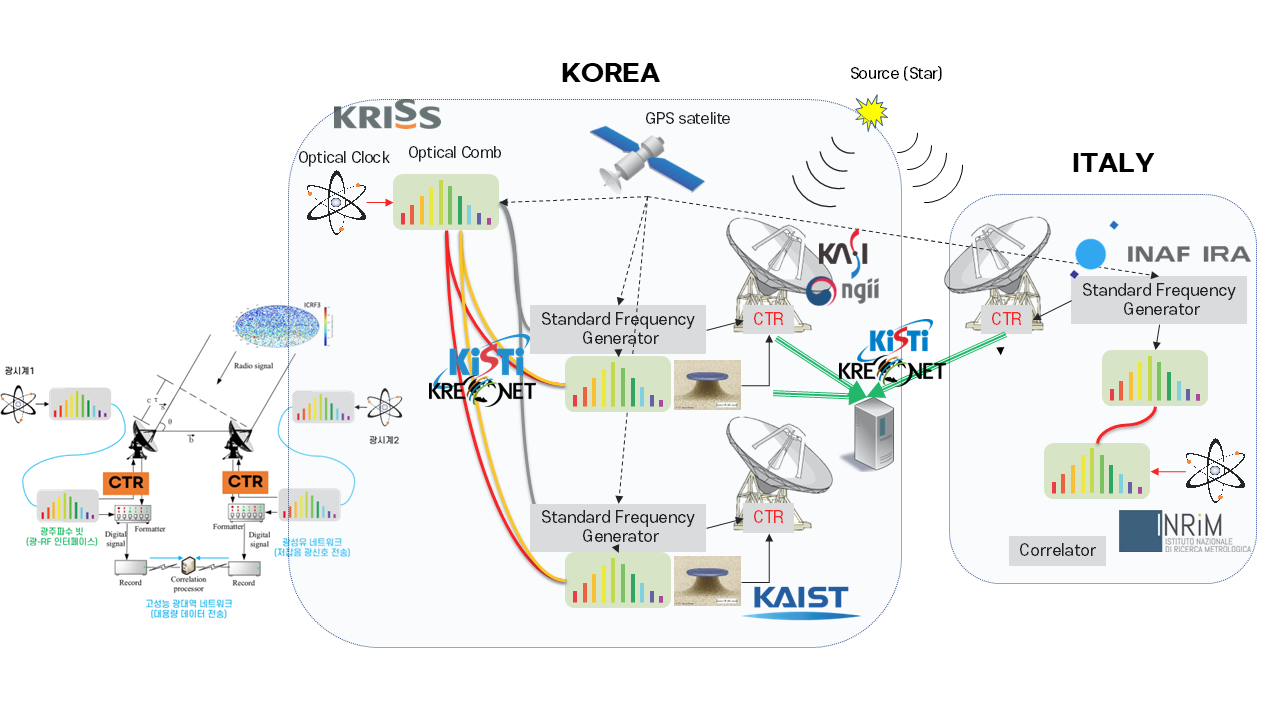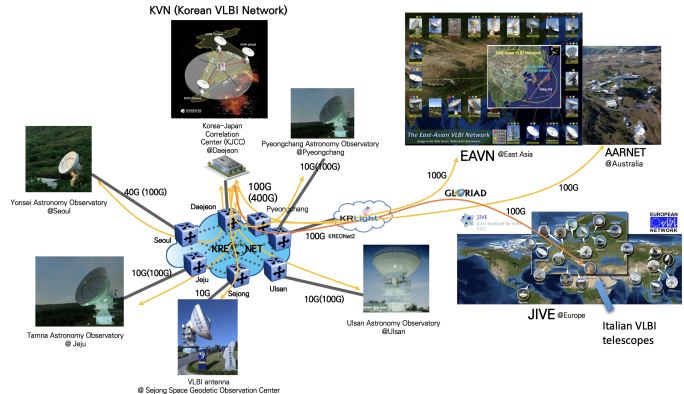Overcoming Precision Limits in Space-Time Measurements for Intercontinental Optical Clock Comparison Using Broadband VLBI
Objective
- Combine the highest precision in time measurement using optical clocks with the highest spatial measurement precision provided by high-frequency broadband VLBI (Very Long Baseline Interferometry) technology. This aims to develop intercontinental ultra-precise optical clock comparison technology at the 10⁻¹⁷ level and beyond, contributing to the redefinition of the second. The project also seeks to overcome the spatial precision limits of VLBI measurements by utilizing next-generation high-frequency VLBI technology.
Duration
June 2022 – May 2027
Collaboration
Korea Research Institute of Standards and Science (KRISS), Korea Institute of Science and Technology Information (KISTI), Korea Advanced Institute of Science and Technology (KAIST), Korea Astronomy and Space Science Institute (KASI)
Funding
79 billion KRW, funded by the National Research Council of Science & Technology’s Creative Convergence Research Program
Key Steps
- Phase 1 : Develop and establish high-frequency broadband VLBI systems and component technologies for the Korean Peninsula’s VLBI network, validate space-time measurement precision limits through domestic VLBI observations, and conduct preliminary research in Italy for high-precision optical clock comparisons.
- Phase 2 : Conduct intercontinental optical clock comparison research with 10⁻¹⁷ or greater time precision through simultaneous VLBI observations linked to optical frequency clocks.
- Develop optical clocks with 10⁻¹⁸ accuracy and ensure stable long-term operation. Transmit precise signals to telescopes with minimal noise.
- Build a high-frequency broadband VLBI observation system based on microwave (MW) signals generated from transmitted frequencies.
- Perform international optical clock comparisons with Italy’s VLBI, equipped with 22/43/86 GHz receivers, to achieve 10⁻¹⁷ level time comparison precision and 1 mm spatial measurement accuracy.
KISTI’s Role
- Develop and establish a low-noise, high-performance optical transmission network for transmitting high-precision time synchronization signals between optical clocks and the Korean space radio telescope.
- Create a high-performance data transmission network for the collection, storage, and analysis of large-scale VLBI observation data from both domestic and international radio telescopes.
- Prepare for the construction of a national optical-based Time/Frequency Network (O-TFN) to support future national time/frequency information transmission services.
Anticipated Outcomes and Benefits
- This project exemplifies converged research that leverages major research infrastructures such as VLBI, optical fiber networks, low-noise microwave generation, and optical clocks from key national research institutions.
- The world’s first high-frequency broadband VLBI network, alongside state-of-the-art optical clocks and high-performance optical networks, will achieve previously unattainable space-time measurement precision.
- The “second” (time unit), redefined after more than half a century since its initial definition in 1967 due to advancements in science and technology, will face its next redefinition. Through this project, Korea will play a leading role in the redefinition of the second and establish itself as a time-keeping hub in Asia.
- The project will enhance the precision of celestial and terrestrial reference coordinate systems, which are fundamental to absolute positioning.
- Contribute to real-time monitoring of crustal movement in Korea, climate change studies, and space mission tracking, such as for Korean space probes. The project will also support the Fourth Industrial Revolution through ultra-precise time/frequency synchronization.
- Secure a sustainable infrastructure for precision space-time measurement, laying the foundation for scientific discoveries and providing services to sectors demanding ultra-precise space-time information.
Project Concept Diagram
Configuration of Domestic and International High-Performance VLBI Data Transmission Networks

